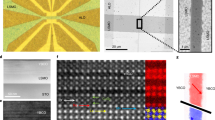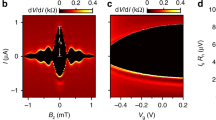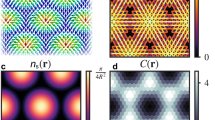Abstract
The phase of the macroscopic electron-pair wavefunction in a superconductor can vary only by multiples of 2π when going around a closed contour. This results in quantization of magnetic flux, one of the most striking demonstrations of quantum phase coherence in superconductors1,2,3. By using superconductors with unconventional pairing symmetry4,5,6,7, or by incorporating π-Josephson junctions8, a phase shift of π can be introduced in such loops7,9,10. Under appropriate conditions, this phase shift results in doubly degenerate time-reversed ground states, which are characterized by the spontaneous generation of half quanta of magnetic flux, with magnitude 1/2 Φ0(Φ0 = h/2e = 2.07 × 10-15 Wb) (ref. 7). Until now, it has only been possible to generate individual half flux quanta. Here we report the realization of large-scale coupled π-loop arrays based on YBa2Cu3O7-Au-Nb Josephson contacts11,12. Scanning SQUID (superconducting quantum interference device) microscopy has been used to study the ordering of half flux quanta in these structures. The possibility of manipulating the polarities of individual half flux quanta is also demonstrated. These π-loop arrays are of interest as model systems for studying magnetic phenomena—including frustration effects—in Ising antiferromagnets13,14,15,16,17,18. Furthermore, studies of coupled π-loops can be useful for designing quantum computers based on flux-qubits19,20,21,22,23 with viable quantum error correction capabilities24,25.
This is a preview of subscription content, access via your institution
Access options
Subscribe to this journal
Receive 51 print issues and online access
$199.00 per year
only $3.90 per issue
Buy this article
- Purchase on Springer Link
- Instant access to full article PDF
Prices may be subject to local taxes which are calculated during checkout



Similar content being viewed by others
References
Bardeen, J., Cooper, L. N. & Schrieffer, J. R. Theory of superconductivity. Phys. Rev. 108, 1175–1204 (1957)
Deaver, B. S. Jr & Fairbank, W. M. Experimental evidence for quantized flux in superconducting cylinders. Phys. Rev. Lett. 7, 43–46 (1961)
Doll, R. & Näbauer, M. Experimental proof of magnetic flux quantization in a superconducting ring. Phys. Rev. Lett. 7, 51–52 (1961)
Geshkenbein, V. B. & Larkin, A. I. The Josephson effect in superconductors with heavy fermions. JETP Lett. 43, 395–399 (1986)
Geshkenbein, V. B., Larkin, A. I. & Barone, A. Vortices with half magnetic flux quanta in “heavy-fermion” superconductors. Phys. Rev. B 36, 235–238 (1987)
Sigrist, M. & Rice, T. M. Paramagnetic effect in high-Tc superconductors—a hint for d-wave superconductivity. J. Phys. Soc. Jpn 61, 4283–4286 (1992)
Tsuei, C. C. & Kirtley, J. R. Pairing symmetry in cuprate superconductors. Rev. Mod. Phys. 72, 969–1016 (2000)
Bulaevskii, L. N., Kuzii, V. V. & Sobyanin, A. A. Superconducting system with weak coupling to the current in the ground state. JETP Lett. 25, 290–294 (1977)
Van Harlingen, D. J. Phase-sensitive tests of the symmetry of the pairing state in the high-temperature superconductors—Evidence for dx2-y2 symmetry. Rev. Mod. Phys. 67, 515–535 (1995)
Schulz, R. R. et al. Design and realization of an all d-wave dc π-superconducting quantum interference device. Appl. Phys. Lett. 76, 912–914 (2000)
Smilde, H. J. H. et al. d-Wave-induced Josephson current counterflow in YBa2Cu3O7/Nb zigzag junctions. Phys. Rev. Lett. 88, 057004 (2002)
Smilde, H. J. H., Hilgenkamp, H., Rijnders, G., Rogalla, H. & Blank, D. H. A. Enhanced transparency ramp-type Josephson contacts through interlayer deposition. Appl. Phys. Lett. 80, 4579–4581 (2002)
Aeppli, G. & Chandra, P. Seeking a simple complex system. Science 275, 177–178 (1997)
Moessner, R. & Sondhi, S. L. Ising models of quantum frustration. Phys. Rev. B 63, 224401 (2001)
Chandra, P. & Doucot, B. Possible spin-liquid state at large S for the frustrated square Heisenberg lattice. Phys. Rev. B 38, 9335–9338 (1988)
Davidovic, D. et al. Magnetic correlations, geometrical frustration, and tunable disorder in arrays of superconducting rings. Phys. Rev. B 55, 6518–6540 (1997)
Pannetier, B., Chaussy, J., Rammal, R. & Villegier, J. C. Experimental fine tuning of frustration: Two-dimensional superconducting networks in a magnetic field. Phys. Rev. Lett. 53, 1845–1848 (1984)
Lerch, Ph., Leemann, Ch., Theron, R. & Martinoli, P. Dynamics of the phase transition in proximity-effect arrays of Josephson junctions at full frustration. Phys. Rev. B 41, 11579–11582 (1990)
Mooij, J. E. et al. Josephson persistent-current qubit. Science 285, 1036–1039 (1999)
Van der Wal, C. et al. Quantum superposition of macroscopic persistent-current states. Science 290, 773–777 (2000)
Friedman, J. R., Patel, V., Chen, W., Tolpygo, S. K. & Lukens, J. E. Quantum superposition of distinct macroscopic states. Nature 406, 43–46 (2000)
Ioffe, L. B., Geshkenbein, V. B., Feigel'man, M. V., Fauchère, A. L. & Blatter, G. Environmentally decoupled sds-wave Josephson junctions for quantum computing. Nature 398, 679–681 (1999)
Blais, A. & Zagoskin, A. Operation of universal gates in a solid-state quantum computer based on clean Josephson junctions between d-wave superconductors. Phys. Rev. A 61, 042308 (2000)
Preskill, J. Reliable quantum computers. Proc. R. Soc. Lond. A 454, 385–410 (1998)
Bennett, C. H. & DiVincenzo, D. P. Quantum information and computation. Nature 404, 247–255 (2000)
Rogers, F. P. A Device for Experimental Observation of Flux Vortices Trapped in Superconducting Thin Films. Thesis, MIT, Boston (1983)
Vu, L. N. & Van Harlingen, D. J. Design and implementation of a scanning SQUID microscope. IEEE Trans. Appl. Supercond. 3, 1918–1921 (1993)
Black, R. C. Magnetic microscopy using a liquid nitrogen cooled YBa2Cu3O7 superconducting quantum interference device. Appl. Phys. Lett. 62, 2128–2130 (1993)
Kirtley, J. R. et al. High-resolution scanning SQUID microscope. Appl. Phys. Lett. 66, 1138–1140 (1995)
Cowley, J. M. An approximate theory of order in alloys. Phys. Rev. 77, 669–675 (1950)
Gardner, B. W. et al. Scanning superconducting quantum interference device susceptometry. Rev. Sci. Instrum. 72, 2361–2364 (2001)
Kirtley, J. R., Moler, K. A. & Scalapino, D. J. Spontaneous flux and magnetic-interference patterns in 0-π Josephson junctions. Phys. Rev. B 56, 886–891 (1997)
Acknowledgements
We thank R. H. Koch, J. Mannhart, D. M. Newns and D. J. Scalapino for discussions. This work was supported by the Dutch Foundation for Research on Matter (FOM), the Netherlands Organization for Scientific Research (NWO), the Royal Dutch Academy of Arts and Sciences (KNAW) and the European Science Foundation (ESF) PiShift programme.
Author information
Authors and Affiliations
Corresponding author
Ethics declarations
Competing interests
The authors declare that they have no competing financial interests.
Rights and permissions
About this article
Cite this article
Hilgenkamp, H., Ariando, Smilde, HJ. et al. Ordering and manipulation of the magnetic moments in large-scale superconducting π-loop arrays. Nature 422, 50–53 (2003). https://doi.org/10.1038/nature01442
Received:
Accepted:
Issue Date:
DOI: https://doi.org/10.1038/nature01442
This article is cited by
-
Flux focusing with a superconducting nanoneedle for scanning SQUID susceptometry
Microsystems & Nanoengineering (2023)
-
Josephson Memories
Journal of Superconductivity and Novel Magnetism (2021)
-
Fractional Solitons in Excitonic Josephson Junctions
Scientific Reports (2015)
-
Resonant phase dynamics in 0-π Sine–Gordon facets
Continuum Mechanics and Thermodynamics (2015)
-
Recent Achievements on the Physics of High-T C Superconductor Josephson Junctions: Background, Perspectives and Inspiration
Journal of Superconductivity and Novel Magnetism (2013)
Comments
By submitting a comment you agree to abide by our Terms and Community Guidelines. If you find something abusive or that does not comply with our terms or guidelines please flag it as inappropriate.



